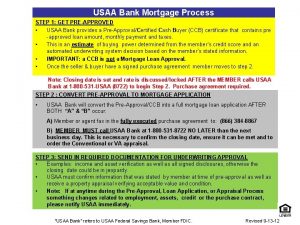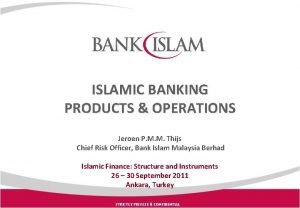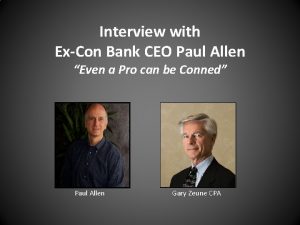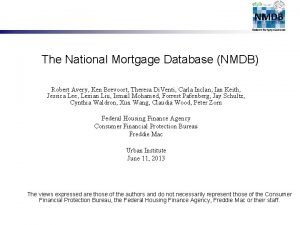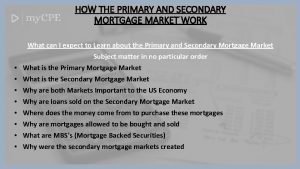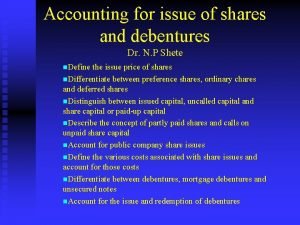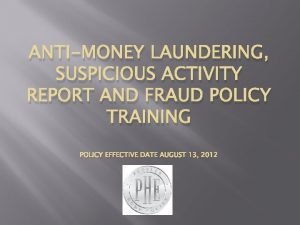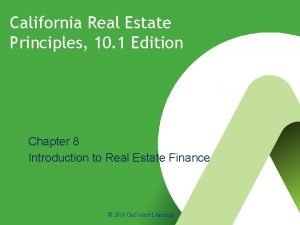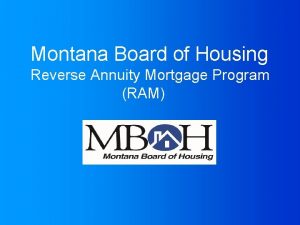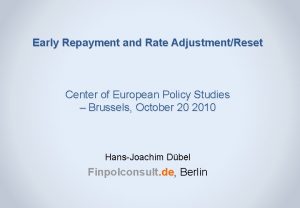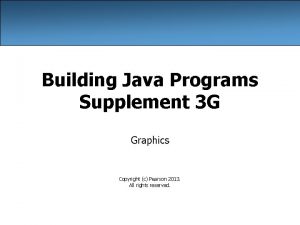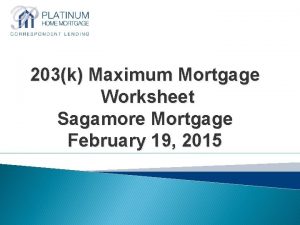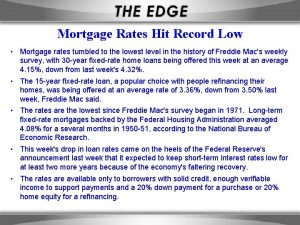Mortgage Credit Panel CREDIT ActivePassive Principals Active Principal
































































- Slides: 64

Mortgage Credit Panel CREDIT

Active/Passive Principals

Active Principal: • Responsible for execution of all activities (operational and financial) for the benefit of the project, regardless of the extent of ownership interest. Ø May be individuals or entities Ø May individually or collectively direct and control borrowing entity Passive Principal: • Has limited or NO decision making power or control. The decision of determining active and passive principals is SUBJECTIVE!

Consider the following when making the decision: Ø Identify how the property owned; understand all layers of the ownership structure Ø Identify the borrower’s experience and qualifications to owning, operating , and managing multifamily real estate Ø Identify who has decision making authority Ø Identify who has financial capability to contribute funds

Be Aware! Ø Not all principals are treated the same! Ø Ownership percentage is NOT the determining factor of whether a principal is classified as active or passive. Ø An individual may own less than 25% (partnership, LLC) or 10% (corporation) but still have operational and financial control. Ø Identify problem areas early

Separate classification from Previous Participation – each has its own guidelines and they may or may not be the same.

Examples of Operational Control in organizational documents include: Ø Develops and approves the annual budget Ø Has approval authority for significant expenses, refinance, dissolution Ø Is able to hire/fire management agents, etc. Ø Appoint staff or decision maker

Active Principals need some level of Mortgage Credit Review: Ø Full Mortgage Credit including REO Schedule (Section 50 signers) Ø Full Mortgage Credit excluding REO Schedule (active principals not signing Section 50) if not a decision maker Ø Limited Mortgage Credit (management agents, general contractors, potentially others)

Full Mortgage Credit review for Active Principals NOT signing Section 50 • Some principals may have financial capacity but not full decision making authority • For example, an investor who has exceeded the $250 million threshold or wishes to avoid exceeding the threshold and invests as a passive investor with less than 25% (or 10% for a corporation) will require a mortgage credit review. * * The new notice is expected to change or eliminate this MAP Guide requirement

GC/MA Credit Review Credit Release/Report Resume Financial Statements HUD 2530 (depends) HUD 92013 SUPP OFAC/LDP/SAM Internet Search ü ü ü ü Other Business Concerns VOD/Bank Statement REO Schedule *required if providing financial support Full Credit Review (not Section 50 signer) ü ü ü ü ü* Full Credit Review (Section 50 signer) ü ü ü ü ü

Examples of Others requiring a LIMITED Mortgage Credit Review Management Agents with Identity of Interest (IOI) • HUD 92013 SUPP; answer 4 questions, can check credit reports for trade references • Resume • HUD 2530 • Financial Statements • Credit Reports • Internet search Management Agents with no Identity of Interest • Waiver of credit reports • HUD 92013 SUPP; answer 4 questions, can check credit reports for trade references • Resume • HUD 2530 • Internet search General Contractors • Resume • Financial Statements • VOD • HUD 92013 SUPP; answer 4 questions, can check credit reports for trade references • HUD 2530 • Credit Reports • Internet search

Passive Principals Are Not subject to Credit Review!! Passive principals have no decision making authority or financial capacity BUT, if a passive principal is providing the initial project cash investment (with no ongoing obligation to support the project), the availability of cash must be verified. Bottom Line: Every case will be different. The MAP underwriter must complete research on the borrower to determine who qualifies as principal and the level of mortgage credit required.

Underwriting Notes: 1. Be careful of structures or layered organizational structures 2. Identify the individuals and entities with operational control (decision makers) 3. Identify the individual and entities with financial capacity 4. Identify anyone who owns a substantial interest in the property, what is their role? 5. Conduct Previous Participation analysis separately 6. Be cautious when identifying passive principals: are they really passive, especially if they own a significant percentage? Is it clear the individual or entity has no say in the project? Are they bringing cash to close? 7. The determination of the principals is subjective; but be able to support the decision. 8. Ask questions to clarify the roles.

APPS/2530 Previous Participation

The big question is Who is included on 2530/APPS?

Answer: Controlling Participants

Who are Controlling Participants? Ø Specified capacities Ø Individuals and entities who have operational or financial control of the specified capacities

Who is“Specified Capacity”? Ø Borrower/owner Ø Management Agent Ø General Contractor

Who are the individuals/entities that control Specified Capacities? Ø Own, directly or indirectly 25% or more of the specified capacity ØControlling owners of entities that control specified capacity ØAny officer (or equivalent, executive management) of specified capacity or controlling participant, directly responsible to the board and have the ability to prevent or resolve violations or circumstances giving rise to flags

Controlling Roles: Ø Manager or managing members of LLC Ø General partners of limited partnership Ø Partners in a general partnership Ø Executive director or equivalent role of non-profit

Controlling Roles: Ø Trustees of a Trust Ø Members of for-profit corporations Board of Directors who are also officers of corporation. Ø Controlling stockholder of corporation. In most cases ownership interest will be at least 25%.

Controlling Roles: Ø Individual or entity who will sign Section 50 of the Regulatory Agreement Ø Any other person or entity determined by HUD to exercise day-today control, financial or operational over a specified capacity.

Controlling Participant Exclusions Exclusion takes precedence over inclusion If entity/individual qualifies for an exclusion, it takes precedence over inclusion requirements

Excluded Individuals/Entities Ø Wholly owned entities – owned 100% by 1 individual or entity Ø Shell entities – don’t take actions themselves, only serve as legal vehicles for partners/members or owners to take action Ø Minor officers of corporation – Do not have “significant involvement” (ability to prevent or resolve violating or circumstances giving rise to flags related to the covered project)

Excluded Individuals/Entities Ø Tax credit investors – Provide LLCI certification Ø Passive participants with no control Ø Members, partners, stakeholders and owners of entities with less than 25% share with no control through another capacity o Effective interest is used to determine “share”. o Consider identity of interest relationships, familial relation or common financial interest in determining effective ownership interest.

Excluded Individuals/Entities Ø Members of Board of Directors, non-profit or for-profit who do not exercise control through another capacity (Executive Director or Officers) Ø Mortgagees Ø Public housing agency

Excluded Individuals/Entities Ø Individual shareholders of a publicly held company and the company itself do not file. The CEO, controlling shareholder and any other individual identified as having day-today-control must file. Ø Any individual or entity determined by HUD not to exercise financial or operational control

Nonprofit entities Controlling Participant Ø Any officer (or equivalent, executive management) of specified capacity or controlling participant, directly responsible to the board and have the ability to prevent or resolve violations or circumstances giving rise to flags Ø Executive director or equivalent role of non-profit Exclusion Ø Members of Board of Directors who do not exercise control through another capacity (Executive Director or Officers)

Corporate Officers vs. Board Officers Corporate Officers CFO, CEO, CIO, etc. President, Vice President, Executive Director Board Officers President, Vice President, Treasurer, Secretary

Organizational Chart Ø Must be clear enough so that a person not familiar with the project and its entities involved can understand the ownership and control structure Ø Not everyone listed on the organizational chart must file previous participation Ø Include all participants (not just principals or Controlling Participants) Ø Include percentage of ownership (totaling 100%) and role Ø List at least one natural person Ø Separate chart for each Specified Capacity

The Processing Guide is your friend Housing Notice 2016 -15

GC Working Capital Analysis

• Work in Progress Schedule • Need contract amount, % complete, remaining balance, retainage • Eliminate jobs 90% or more complete • Is the GC in negotiations on any other contracts?

• Historical Operating Statements • 3 years of audits and Year to Date • Look at all four years for consistency in income and expenses, and assets and liabilities – question significant changes • Request bank statements for cash and investment accounts to verify liquid assets • Evaluate the Current Assets and Current Liabilities – are they classified correctly? Current assets are those assets that can be liquidated quickly or are expected to be received within 12 months.

• Aging Accounts Receivables • What are the expectations of collecting of anything over 90 days old • Adjust Current Accounts Receivables • Bonding Capacity • Does the GC have remaining bonding capacity to cover your project? • Is the GC in negotiations on any other contracts? • Talk to the Bonding Agent

• Lines of Credit • Evidence of LOC. How long is the LOC good for? Have they ever drawn on it? • Other Business Concerns • Are there affiliates that money transfers back and forth. • Intercompany loans? • Loans to Principals?

Be Aware! Ø Evaluate Working Capital early! Worse thing that could happen is you wait until you have the HUD-2328 and find out there are issues with the 5%. Ø Identify problem areas early – talk to the CFO or Comptroller – make sure you clearly understand the assets and liabilities. Ø Not all contracts are the same!

Pre-application Mortgage Credit Requirements

Section 221(d)4 Pre-application mortgage credit • The organizational structure is generally preliminary and organizational documents are not finalized • Main players may be involved but their role in the final structure may not yet be determined • Often management agent, general contractor and possibly architect are not known or will change prior to firm application • No specific requirements in the MAP Guide

Section 221(d)4 Pre-application mortgage credit requirements Mortgagor • Organizational chart- subject to change • Financial Statement – N/A if a newly formed entity • 2530/APPS – Is this available with organizational structure subject to change? Principals • Internet search • OFAC/LDP/SAM search • Resumes, list of experience • Principal REO and Maturing Debt Schedule – Is this available with organizational structure subject to change? • Lender’s prerogative: Principal financial statements may be requested to verify REO schedule. Statements are not required to be submitted with pre-application.

Section 221(d)4 Pre-application mortgage credit requirements Management Agent, General Contractor, Architect, Energy Consultant • Resume, list of experience

Section 221(d)4 Pre-application mortgage credit requirements If information is not available at the pre-application stage, what are best practices for the mortgage credit review?

Mortgage Credit Panel HUD

Concentrated Risk Ø Increasing levels of credit authority, recurring approvals and limited staff induced proposed changes to process Ø Suggested Changes will include: ØIncrease size of loan balance threshold to $500 M ØIncrease length of approval to two years (from one) ØMay require additional review/approvals as loan balances increase 44

Foreign Nationals • A Foreign National can be an Active or Passive Principal • Section 8. 2 of the MAP Guide requires that: – At least one principal with operational decision making authority must be a US Citizen, or a foreign national lawfully residing in the US (green card) • Domestic Principal – US citizen with operational control – significant assets and net worth commensurate with planned project – Is required if foreign national(s) are passive – Lender must identify relationships of domestic principal to foreign national 45

Foreign Nationals • Active Principal - require SSN, eligible immigration status – No SSN, cannot be an Active Principal • Passive Principal - no SSN as no 2530 filing required – ITIN’s cannot be used in place of an SSN 46

Foreign Nationals • If passive, must disclose identification of individual – Required for OFAC search – Lender must certify that org docs confirm passive role – Passive investor (or entity) must certify that interest is passive 47

HUD Large Borrower Review A Practitioner’s Perspective

ML 2010 -21: Risk Mitigation • “Particular attention and additional scrutiny” to principals with greater than $250 million of FHA insured debt • Lender review of REO Schedule determines if the principal meets the $250 million threshold • HUD pre-approval required before such principals can apply for additional FHA mortgage insurance

What were the concerns? • The Department’s Concern – Financial or credit problems could destabilize the principal’s FHA insured assets? • The Industry’s Concern – Large Borrowers represent our Top Tier clients and will this approval discourage them from applying for FHA insurance?

ML 2013 -09: Concentration of Principal Risk • ML provides clarification to the 2010 ML and establishes processing procedures • $250, 000 threshold more clearly defined as currently insured assets plus any proposed additional commitments • Alternatively, principals with 25 or more commercial assets (includes MF) have the option to seek prior approval even if HUD insurance < $250 million

ML 2013 -09: Concentration of Principal Risk • Applies to all applications for FHA multifamily insurance except for 223(a)(7) • Does not apply to programs administered by the Office of Healthcare • However, in evaluating the $250 million threshold FHA insured Healthcare loans do count toward the total

ML 2013 -09: Concentration of Principal Risk • What do we want to conclude about Large Borrowers? 1. Is the Principal a credit risk given the performance of currently FHA insured and other properties? 2. What is the appropriate increase in credit authority (insured loan balance)? 3. Are there asset combinations that present credit risk?

ML 2013 -09: Concentration of Principal Risk § Cont’d 4. Allow HUD to provide efficient credit approvals to Principals who have FHA insured assets across different regions 5. Assist largest users of FHA insurance to plan for future FHA insured transactions

ML 2013 -09: Concentration of Principal Risk • Pre-Approval is Mandatory – New Pre. Applications or Firm Applications not accepted without Prior Approval • Technical Support Division of Office of Multifamily completes the review and issues the Prior Approval • Complete Mortgage Credit Review of Principal required with additional requirement of forecast of material changes in financial position over the following 12 months

ML 2013 -09: Concentration of Principal Risk • Approvals are issued by HUD to cover a defined timeframe and can include conditions such as: ØList of new projects for which new applications will be accepted ØExceptions on types of projects or geographic markets for proposed new applications ØMaximum amount of FHA insurance ØMinimum principal liquidity requirements

ML 2013 -09: Concentration of Principal Risk • Process or submission of Prior Approval request ØDesignation of Lead MAP Lender – Selected by Sponsor ØDescription of Principal and their roles including contact information, organizational charts and resumes. ØFull Mortgage Credit review for each Principal per MAP Guide Chapter 8 guidelines

ML 2013 -09: Concentration of Principal Risk • Process or submission of Prior Approval request (Cont’d) ØREO Schedule Analysis 1. All properties owned (FHA insured and not) with individual asset and aggregate portfolio analysis. 2. For FHA insured assets analyze physical condition (REAC), occupancy and debt coverage. 3. For non-FHA assets focus on debt maturities and stress analysis (debt coverage less than 1. 10)

ML 2013 -09: Concentration of Principal Risk • Process or submission of Prior Approval request (Cont’d) ØREO Schedule Analysis 4. For non-residential assets, Principal or Lender to obtain additional analytical resources (if necessary) 5. Proposed FHA insured transactions with estimated cash requirements and financing plan to meet those requirements

ML 2013 -09: Concentration of Principal Risk • Process or submission of Prior Approval request – Other Considerations ØSuccession plan if likelihood of incapacity ØSEC filings are acceptable if Principal is a publically traded entity ØConfirmation that the Principal is not a defendant in a legal action involving the Federal Government nor is delinquent on any Federal debt

ML 2013 -09: Concentration of Principal Risk • Lender Analysis and Recommendation ØIs ownership and management stable? ØWhat challenges confront the Principal and is a plan in place to meet these challenges? ØWill proposed additions to the Principal’s REO Schedule make the portfolio stronger? ØIs there financial capacity and forecasted cash flow available to meet anticipated needs? ØDoes the Principal have a good track record?

ML 2013 -09: Concentration of Principal Risk • Technical Division Review and Decision Ø 30 Day Review Period ØExplain decision identifying areas of strength or weakness ØInclude any proposed conditions to the approval ØIdentify specific proposed transactions for FHA insurance and minimum cash or liquid assets required to close those transactions

MAP Guide (January 2016) – Chapter 8. 6 • For Principals with greater than $250 million, the Lender must not adjust for the Principal’s fractional ownership percentage • Prior approval required for investors with greater than $250 Million but who wish to invest in future projects in passive role < 25% • Prior Approval good for 24 months or lesser period at HUD’s discretion

MAP Guide Appendix 8 C – Prior Approval Requirements • Generally consistent with ML 2013 -09 • A few notable comments/exceptions ØHUD will accept a mortgage insurance application subject to Large Borrower approval in certain instances Ø 2530/APPS is an exhibit for each individual application and not for the Prior Approval submission ØLanguage referring to organizational charts has been removed (Roles in individual transactions)
 Ohfa mortgage tax credit
Ohfa mortgage tax credit Continuous panel vs discontinuous panel
Continuous panel vs discontinuous panel Zıt panel
Zıt panel 10 principles of cooking
10 principles of cooking South african principals association
South african principals association Icponline.org
Icponline.org Time management for principals
Time management for principals Naplan online training
Naplan online training Brings together a composition with similar units.
Brings together a composition with similar units. Universal principals
Universal principals Na guiding principles
Na guiding principles Auckland primary principals association
Auckland primary principals association Elements of design in fashion
Elements of design in fashion Kiwi leadership for principals
Kiwi leadership for principals Membrane structures that function in active transport
Membrane structures that function in active transport Boolean operators
Boolean operators Primary active transport vs secondary active transport
Primary active transport vs secondary active transport This can be avoided by giving credit where credit is due.
This can be avoided by giving credit where credit is due. 7-3 mortgage application process
7-3 mortgage application process Jason arkell
Jason arkell Usaa home loan pre approval
Usaa home loan pre approval Wadiah yad amanah
Wadiah yad amanah Townsend mortgage company excel
Townsend mortgage company excel Powerhouse mortgage solutions
Powerhouse mortgage solutions Paul r allen
Paul r allen Mortgage rate
Mortgage rate Suncrest solar
Suncrest solar Mortgage krizi
Mortgage krizi Lgss valuation
Lgss valuation National mortgage database
National mortgage database What is futures trading
What is futures trading Deephaven mortgage reviews
Deephaven mortgage reviews Mortgage backed securities diagram
Mortgage backed securities diagram Highland commercial mortgage
Highland commercial mortgage Primary vs secondary mortgage market
Primary vs secondary mortgage market Reverse mortgage solutions reo properties
Reverse mortgage solutions reo properties Amerinatls
Amerinatls Chfainfo.your mortgage online.com
Chfainfo.your mortgage online.com Debenture mortgage
Debenture mortgage Absa borrowers education training
Absa borrowers education training The hong kong mortgage corporation limited
The hong kong mortgage corporation limited Brian sacks mortgage
Brian sacks mortgage Deephaven mortgage reviews
Deephaven mortgage reviews Pwsb belgium
Pwsb belgium Mortgage chunking definition
Mortgage chunking definition Difference between hypothecation and mortgage
Difference between hypothecation and mortgage Revolution mortgage near me
Revolution mortgage near me Bian capability model
Bian capability model Math 1050 mortgage project
Math 1050 mortgage project Gpam mortgage loan
Gpam mortgage loan Mboh loan servicing
Mboh loan servicing Prospect mortgage
Prospect mortgage Huecu mortgage rates
Huecu mortgage rates Rafiq's monthly mortgage payment
Rafiq's monthly mortgage payment Bcps new teacher orientation
Bcps new teacher orientation Panel data example
Panel data example Adult treatment panel iii
Adult treatment panel iii Epic training uw
Epic training uw Kesit verisi örnek
Kesit verisi örnek Panel facilitator
Panel facilitator Pys.tubitak
Pys.tubitak Sharon soper
Sharon soper Java drawing panel
Java drawing panel Sungold solar panel
Sungold solar panel Cm level 6 technique
Cm level 6 technique




















